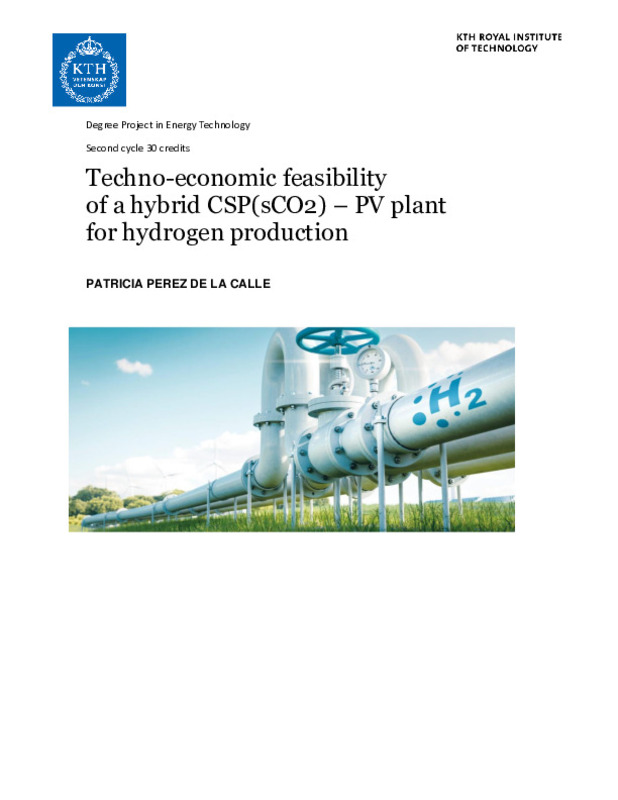|
Resumen:
|
[EN] The global need to eliminate CO2 emissions and its consequent reduction in the use of fossil fuels
drives the ongoing energy transition that highly involves the research achievements of the scientific
community to ...[+]
[EN] The global need to eliminate CO2 emissions and its consequent reduction in the use of fossil fuels
drives the ongoing energy transition that highly involves the research achievements of the scientific
community to reach the goals of this purpose. Renewable sources like photovoltaic and wind energy,
are central to this endeavor, however, the intermittency of natural resources makes it nondispatchable and energy storage is fundamental. According to the European Roadmap [1] just a 60%
of the CO2 emissions reduction goal can be achieved with available technologies and existing energy.
However, the production, use and specially storage opportunities that hydrogen offers can drive nondispatchable renewable sources to achieve its full potential by clearing up the intermittency problem
as well as covering the remained 40% gap.
This master's thesis aims to investigate the techno-economic feasibility of integrating a Solid Oxide
Electrolyzer Cell (SOEC) into a hybrid PV-CSP(sCO2) plant. The study focuses on assessing various
indicators related to electricity, energy, and hydrogen production prices. To achieve this, three
different integration strategies within the hybrid PV-CSP(sCO2) plant were selected for analysis: Soec
using heat from the particles coming from the receiver, soec using heat coming from the particles
available in the thermal energy storage (TES) and soec recovering heat from the sCO2 power block.
A sensitivity analysis was conducted on different PV sizes (MWp), battery capacities (MWh), and
SOEC installed capacities (MWh) to investigate the technology's potential in the plant and determine
optimal sizing of subsystems. However, the individual optimization of economic indicators presented
technical and economic challenges. Scenarios allowing individual optimization of hydrogen
production prices (€/kg H2) resulted in 10.9, 11.7, and 14.6 €/kg h2 for receiver, TES, and sCO2
integration strategy, respectively. These scenarios, however, require high SOEC installed capacities,
leading to elevated electricity and energy production prices. On the other hand, the individual
optimization of electricity and energy production prices led to better and lower results when no
hydrogen production presence within the plant. However, this analysis also showed that soec
capacities below 5MWh together with no installation of batteries and a new definition for calculating
hydrogen production prices (LCOH) allows feasible integration of hydrogen production within the
plant. LCOH(€/kg h2) results were 10.2€/kg h2, 7.6€/kg h2, and 9.4€/kg h2 for receiver, TES, and
sCO2, respectively, for a soec installed capacity of 0.5MWh (119m2 size) along with energy production
values not exceeding 101€/MWh.
While the results present a favorable outlook for SOEC installations based on literature review data
[2] [3] [4] they still face challenges when competing with the cost-efficient PEM technology, which
offers 4.5-5.5€/kg H2 [5] without storage. Nonetheless, this research contributes valuable insights
into the integration of SOEC technology within hybrid renewable energy systems and provides a
comprehensive analysis of the techno-economic aspects related to hydrogen production following
different integration strategies. The findings may inform decision-making processes and promote
further advancements in sustainable energy solutions.
[-]
[ES] Este trabajo de fin de máster propone una configuración híbrida formada por dos sistemas de generación: una Planta Solar de Concentración (CSP) y una planta FV. De esta forma, la producción de electricidad no se limita ...[+]
[ES] Este trabajo de fin de máster propone una configuración híbrida formada por dos sistemas de generación: una Planta Solar de Concentración (CSP) y una planta FV. De esta forma, la producción de electricidad no se limita únicamente a las horas de sol sino también al resto del día.
La principal ventaja de implementar una planta CSP es la adición de un almacenamiento de energía térmica (TES) en el que un fluido de transferencia térmica proveniente del campo CSP cede el calor a las partículas contenidas en el silo caliente (carga) ahorrando la energía que no ha se ha usado a lo largo del día. Finalmente, la energía se utilizará para impulsar un bloque de potencia (descarga) de CO2 supercrítico para generar electricidad que se inyectará a la red o calor.
Finalmente, también se instalará un electrolizador de alta temperatura a lo largo de la línea de producción térmica, muy probablemente uno de óxido sólido para la producción de hidrógeno verde.
Los principales derivados de este trabajo de fin de máster serán:
¿ En primer lugar; una revisión de la literatura o el estado del arte sobre el sistema CSP de alta temperatura, sobre los ciclos de potencia de sCO2 y sobre SOEC.
¿ En segundo lugar; modelo e integración de la configuración de ambos sistemas en un lugar aún por definir (muy probablemente en España) mientras se busca el lugar más adecuado para instalar un electrolizador de alta temperatura (SOEC) entre los tres lugares propuestos en la línea de almacenamiento térmico.
Esto significa, para el caso de la planta de CSP: calcular el área de apertura de la planta, el número de horas con TES, así como el tamaño de los silos frío y caliente y, finalmente, dimensionar los elementos del bloque de potencia, como el vapor. turbina.
Para la planta solar: calcular el pico de potencia de la planta así como el número de paneles, inversores y baterías.
¿ En tercer lugar; la optimización de la producción de electricidad, calor e hidrógeno atendiendo a diferentes parámetros técnico-económicos como: LCOE, LCOH, NPV, PB, eficiencia global de las plantas CSP y PV y comparación de diferentes escenarios.
¿ Finalmente; una conclusión sobre si es factible o no llevar a cabo esta configuración.
[-]
|







